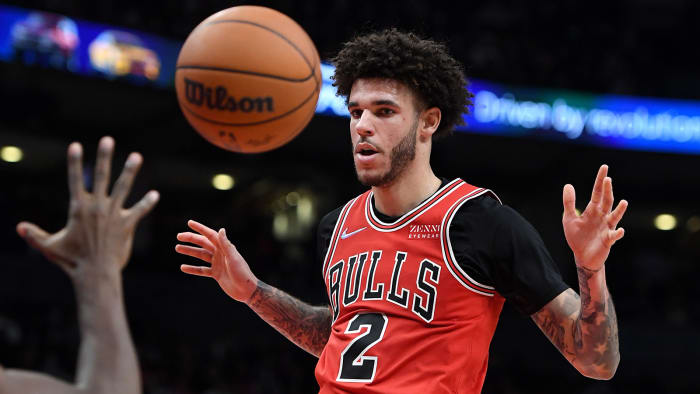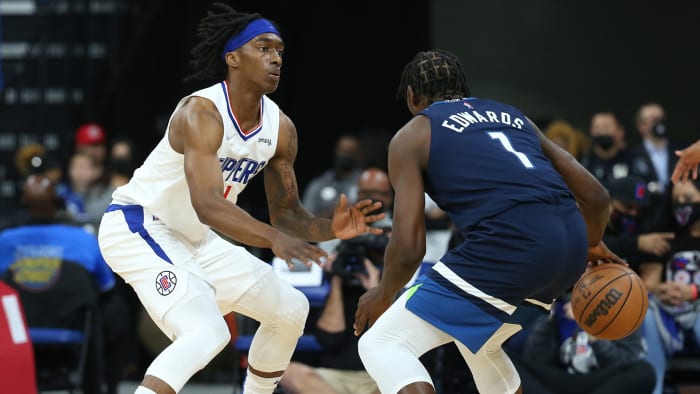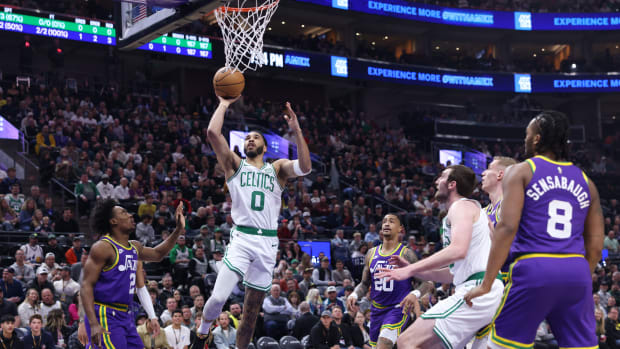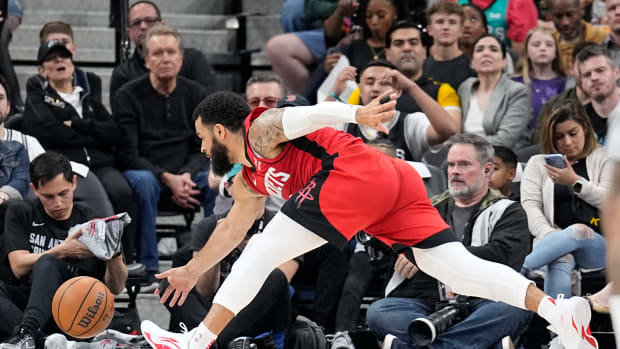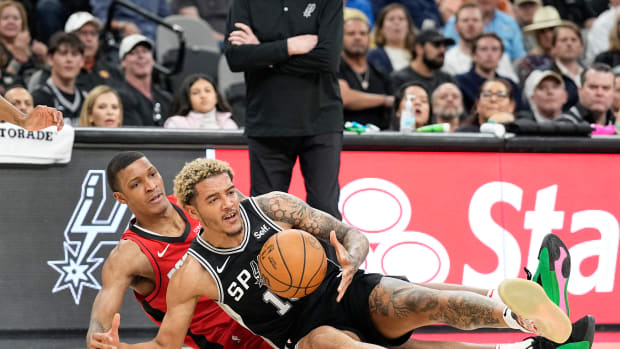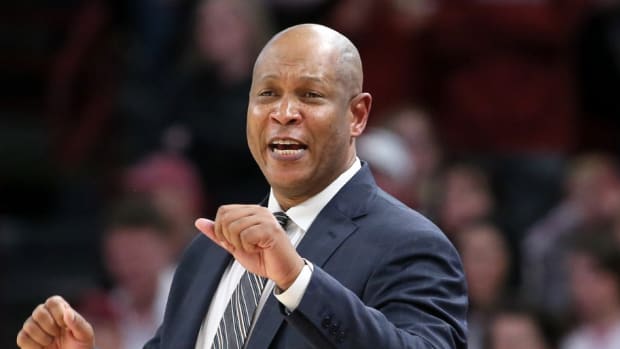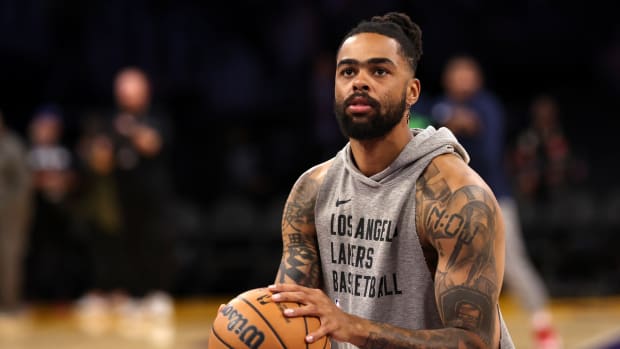10 Early NBA Season Trends to Watch
We’re eight days into the 2021-22 NBA season, where there are far more questions than answers. And since it’s too soon to dig too deeply on any one thing, here are 10 different teams, players, coaching decisions and compelling trends to monitor in the days, weeks and months ahead.
LeBron’s Defense Isn’t Great; Needs to be Great
The Lakers have myriad issues that can, at best, be described as growing pains. At worst, they’re foundational fatal flaws. LeBron James’ defense is neither of those things this early in the season, but Los Angeles is toast if his indifferent approach to getting stops in the opening week carries through the winter.
To be fair, every player in the league has letdowns on that side of the ball, plays where they look disinterested, confused or tired. The season just started and, overall, James has been decent on defense. But thanks to how Rob Pelinka constructed this roster, decent defense from LeBron won’t do.
As L.A’s second-best defender and one of four or five players on the whole team who at least pass for average on D, the Lakers need their 36-year-old king to commit every night. Alex Caruso and Kentavious Caldwell-Pope aren’t walking through that door. James can’t bottom out, which is a version of what we’ve already witnessed.
LeBron has jogged into shot contests and watched opponents smoke his teammates on their way to the rim without flinching. The intensity comes in spurts, which on one hand is entirely understandable for a legend in his 19th season who shouldn’t be asked to treat every play like it’s Game 7 of the NBA Finals. On the other, that exact attitude might be what a team that employs Russell Westbrook, Carmelo Anthony and Malik Monk really needs.
Look at his effort on this first-quarter closeout (a generous description of what James actually does) against Mikal Bridges.
Later on, he’s caught sleeping when Bridges front cuts to the rim for an easy dunk.
A few minutes later, he nearly executed one of his signature chasedown blocks against Cam Johnson and then opted not to cross halfcourt and join his four teammates for the ensuing offensive possession.
This isn’t the first time James has performed this way, though in earlier examples the explanation was body preservation. Perhaps that still applies in the season’s second game against a contender while down 30 points. But there’s also the matter of being locked in to the point where he’s able to help teammates when they screw up (which they will do and have done quite a bit already).
The reality LeBron finds himself in calls for harsh criticism, even when a breakdown isn’t directly his fault, like the sequence below. Guarding the inbounder on this pet baseline out of bounds play against the Grizzlies, Ja Morant wiggles free after a screen set by Jaren Jackson Jr. It’s a play Memphis successfully ran in its first two games, and succeeds when the two defenders directly involved (in this case Westbrook and Anthony Davis) fail to switch.
Instead of anticipating the slip and being a step ahead of it to contest the shot or take the pass away, LeBron swipes at Morant and allows an easy bucket. Now, again, this is not his fault. But this one possession is already indicative of a worrying trend, where one of LeBron’s teammates will botch a switch or rotate incorrectly or stand still when they should sink in to help on a drive. He can’t plug every hole, but when those mistakes are compounded by his own inability to go 100% on every play it’s a humongous problem.
This isn’t 2018, when James knew his own brilliance in the postseason could overcome the Cavaliers’ crappy defensive habits. There’s a very real universe where the Lakers don’t make the postseason without him flashing that game-changing athleticism with maximum effort on a regular basis.
Below is what that looks like, the type of hustle that can inspire and invigorate every single one of his teammates when they watch him go all out in a situation most players would give up on.
The goaltend doesn’t matter. His earnest try to reject the layup does.
Why is Offense Down?
Last season yielded some of the most efficient offenses in NBA history. A trend had seemingly been accelerated, with the league’s average offensive rating coming in at a whopping 112.3—a high since at least 1974. Five years prior in 2016 it was 106.4 and 15 years before that it was 103. Three-point shots, gravity and leveraged space all helped offenses rise.
It’s very early, but so far the season’s average offensive rating is down at 106.7, aka lower than any point since Kevin Durant teamed up with the Warriors. There’s a bunch of reasons why this is, and it should go without saying that such a small sample size negates any definitive conclusions. But the NBA’s much ballyhooed officiating change and the time it’ll take for refs and players to adapt could be the biggest cause.
Through just over a week of games, the NBA’s average free-throw rate is .167, which happens to be an all-time low. (Last year it was .192 and the season before that it was .201.) Three-point attempts are up and so is pace, but there’s nothing quite like ending a possession with two free shots at the line—especially if you’re James Harden. Right now this is probably nothing, but if offenses don’t bounce back to the trajectory they’ve been on, it’s worth circling back to.
Confident Cam Reddish!
When Hawks forward De’Andre Hunter was recovering from knee surgery in Los Angeles, as his teammates battled the Bucks in the conference finals,, all he wanted was for Cam Reddish, his best friend on the team, to play more minutes.
“I'm like, if they play Cam we'll have a better shot winning these games,” Hunter told me in September. “And he came out in Game 5 and 6 and was doing his thing. I'm like, it could be a completely different series if we played him one more game earlier.”
Reddish hit six threes and scored 21 points in the last game of Atlanta’s season. He wasn’t shy about getting shots up that night and, despite missing over half of the regular season with an injury and being inactive for the first two playoffs rounds, came into it feeling like there wasn’t much to lose. When I asked him about that game a couple months ago, Reddish recalled his approach: “I know mentally, I'm like eff it,” he said. “It's time to play. Like, I'm not tired now.”
That mentality has carried over into the start of his third season, where Reddish is now playing with a superstar’s green light, jacking up 27.2 shots per 100 possessions. By comparison, Nikola Jokić is at 26.2, Giannis Antetokounmpo is at 26.5, Luka Dončić is at 27.1 and Joel Embiid is at 26.0. (Also, Reddish’s usage is 29.4%, which … what is even happening?)
Coming off the bench in lineups that are designed to prop him up, none of this is a bad thing so far. He’s showing off different parts of his offensive arsenal as an independent shot creator with size who also loves to scrap on the defensive end. Compared to the first two years of his career, way more of Reddish’s looks are coming from mid-range. (Last year 4.9% of his attempts were between 16 feet and the arc. This year it’s over 20%.)
If this aggression keeps up with modest efficiency, the 22-year-old will waltz into Sixth Man of the Year debates. And, as someone who’s extension eligible next summer, a sizable pay day will be right behind.
Running with the Bulls
The Bulls’ offseason overhaul mostly skewed toward offensive talent. But so far the most intriguing contributions made by their new players (especially Alex Caruso and Lonzo Ball) have impacted the defense, which in turn is allowing Chicago to take shape as one of the most adrenalized open floor attacks in basketball.
Do not get sloppy against Chicago, or hesitate for a second racing back off a missed shot. The Bulls will ram the ball down your throat. Last year they ranked 26th in opposing turnover percentage. Now they’re third, with a 7.8% jump. Caruso (whose teams always generate more turnovers when he’s on the court) and Ball (whose teams always have more success in transition when he’s in the game) are invigorating the defense and creating easy chances, sometimes off a deflection (Chicago finished 26th in that category last season; right now they’re fourth) or even just a quick push off a missed shot or lengthy pitch ahead off a made one. The Bulls’ collective mindset is different than it used to be—you don’t make a touch pass like this if your mandate is to set up a half-court offense.
(After Caruso made that reverse and-1 layup, the crowd serenaded him with an M-V-P chant, which feels appropriate.)
Here’s 32-year-old DeMar DeRozan keeping his foot on the gas with no man advantage. Even when it doesn’t work out, the Bulls’ relentless pressure makes handling all their firepower harder than it’d otherwise be. Chaos is their friend.
Possibly related to their blooming open-floor audaciousness and some of the new faces onboard: the Bulls finished last in free-throw rate a year ago; now they’re third. This team might be good, even if they haven’t defeated any teams that are expected to make the playoffs.
The Cavaliers Are Stuck in the Past and That Might be a Good Thing
In 2021 it makes very little sense to play three seven-footers at the same time when one of them can’t guard anybody and none are especially known for making plays. But the Cavaliers are doing it anyway, with Jarrett Allen, Evan Mobley and Lauri Markkanen.
Cleveland ranks 19th in defensive rating. But through four games, they’re allowing only 98 points per 100 possessions with Allen, Mobley and Markkanen on the floor. (For reference, the Lakers led the NBA in defensive rating a year ago at 106.8.)
There’s a chance J.B. Bickerstaff changes things up and moves Markkanen to the bench for Isaac Okoro, last year’s lottery pick who actually provides the wing defense these Cavaliers severely need. But at the same time, assuming Collin Sexton and Darius Garland remain the starting backcourt, Markkanen is a key spacer on offense. And Allen and Mobley may have what it takes to keep everything intact.
These two make a ton of sense together, holding up on switches, dropping, showing in the pick-and-roll. They contest jumpers and protect the rim, rebound, delete passing lanes and take potential cutters away with their length and activity. Watching them interact is an early season League Pass delight.
In their surprising win against the Hawks on Saturday night, the Cavaliers briefly went to a 3-2 zone in the third quarter. Mobley roamed at the top, a look that flummoxed Trae Young and stalled Atlanta’s offense for a few possessions.
The idea was inspired by how Flip Saunders once used Kevin Garnett. “Seeing Evan’s ability to move through that made me think of when KG was playing at the top of that zone,” Bickerstaff said after the game. “So over the summer we went and studied it a bunch and put it in.”
The zone was deployed with Markkanen and Allen also on the floor, and may be one way for this team to get stops against opponents who just want to attack Lauri (as the Grizzlies did in their opener) with pick-and-roll after pick-and-roll.
As the season goes along, offenses that expect it will have an answer. But right now it’s fun, unique and effective. Let’s enjoy this starting five while it lasts. There’s none other like it right now.
There’s Only One Rob Williams
The most unpredictable livewire who happens to play center, even though so much of what he does is its own position; everything Robert Williams III brings to the table is as invaluable as it is singular. His passing is well-documented, but as the full-time starting center in a new system, it’s worth appreciating.
Ball movement is going to be a bellwether for Ime Udoka’s offense. Last year the Celtics finished 27th in assist rate. Right now they’re fifth. Williams’ ability to see cuts and cracks when positioned to survey the floor, as he does here, is one reason why.
Damian Lillard’s Playing Time is Different Under Chauncey Billups
Since late December 2018, Lillard’s typical substitution pattern would see him exit the game after playing the entire first quarter—a look only shared by Steph Curry. Through the first three games of this season, though, Lillard has taken a seat earlier on, watching the last few minutes of the first and third quarters from the sideline, a seemingly minor adjustment with important ripple effects. The obvious impetus is mileage. Since he entered the league in 2012, no player has logged more minutes than Lillard, who leads Harden by about 380 and LeBron by 2,200.
And in those minutes, Portland’s All-NBA point guard has assumed a monstrous usage rate (only eight players are above him since 2012) while taking a physical beating. Lillard is 31 years old, and the Blazers’ season will self-destruct if he misses any meaningful time due to injury. They also have no chance in a potential playoff series or play-in battle if he’s not as fresh as he can possibly be. Cutting into that load may pay dividends. It also opens up opportunities for some of the younger Blazers on vital developmental tracks, be it Anfernee Simons, Nassir Little or even Dennis Smith Jr. (who I will never give up on).
The Blazers can tinker with different lineup combinations that will help their defense and improve the ongoing two-way disparity that cost Terry Stotts his job. There’s no promise any of this works (Portland’s defense still offers less resistance than a shower curtain) but it doesn’t hurt for Billups to try something new in a situation that’s staler than most.
Terance Mann’s Defense is Too Good
If without Kawhi Leonard, the answer to “Who’s the best defender on the Clippers?” is Terance Mann, this team is going places. The roster isn’t loaded with All-Defensive team candidates, but it does have Paul George and Eric Bledsoe. Nicolas Batum, Ivica Zubac, Serge Ibaka, Marcus Morris and Justise Winslow aren’t slouches, either.
But Mann might be the best and most important of the bunch. His presence on that end—from shutting down Steph Curry for lengthy stretches of their opening night loss to hounding Morant over the weekend and smothering C.J. McCollum in L.A.’s blowout win on Monday—is uncanny and game altering. Before he snatches the rebound, just watch how attached he is to McCollum trailing this ball screen. The energy is incessant.
Mann’s on/off differential is one of the league’s best, which passes the smell test when you watch him make an opposing elite scorer fight for every inch. Last year, Mann told me he wasn’t sure what his role was on a loaded team that already had so much shooting, shot creation and versatility. But, in addition to everything else he does so well, the simplest and most accurate label might be stopper.
Watch NBA games online all season long with fuboTV: Start with a 7-day free trial!
It’s Been a Slow Start for De’Aaron Fox
Through the Kings’ first three games, Fox’s PER is in the single digits. He’s shooting 38.6% from the floor and turning it over on 15.1% of his drives (which is almost more than Kevin Porter Jr., who committed two turnovers while I typed this sentence).
Last year he turned it over on only 6.6% of his drives. Drives are important for Fox. He’s fast, with an evolving pull-up game and at-the-rim finishing ability that was second to none at his position a year ago. It’s too early to get too worked up about any one individual’s performance, especially when some of it’s tied to a shooting slump. But the Kings can actually do stuff this year. And the longer it takes for Fox to look as good or better than he’s ever been, the narrower their margin gets to snap the NBA’s longest playoff drought.
What if Nickeil Alexander-Walker is Really Good?
The Pelicans are the most depressing team in the NBA and will be until Zion Williamson is healthy. But there’s a silver lining in every situation, and right now in New Orleans it may be Alexander-Walker. Ignore the numbers—which look terrible thanks to a very bad 6-for-24 shooting night against the Timberwolves—and focus on the potential.
With big minutes and a sudden promotion as essentially New Orleans’ No. 2 offensive option, Alexander-Walker is taking on a lot right now. But he’s a fluid scorer with smooth handles and what should settle in as a pretty good outside shot, with a quick release that he’s already shown plenty of confidence in. (Only Steph Curry and Jayson Tatum have attempted more threes.)
Can he be the third option on a very good team—with, of course, Zion and Brandon Ingram as the fulcrums? The early returns on his third year may place him on that track, and his efficiency will only rise once Williamson returns and opponents are forced to expend their defensive energy elsewhere.
The Pelicans are a gloomy organization right now. But a leap from Alexander-Walker could change everything.
More NBA Coverage:
• NBA Power Rankings: First Impressions for All 30 Teams
• Is This the End of NBA Dynasties?
• The NBA 75: Biggest Snubs, Surprises and Ranking Best Players
• How Chicago Became the NBA's Most Intriguing Team
Sports Illustrated may receive compensation for some links to products and services on this website.






























